In a previous article (Growing Vegetables in Containers- Growing your own Meals) I omitted the growing of potatoes and tomatoes in containers, as I wanted to go into their growing in greater details.
In this article, the growing of potatoes and tomatoes will be discussed, as these are the most grown vegetables in the UK. They tend to be some of the easiest vegetables to grow, but only if you follow the right methodology, otherwise poor yields can result.
POTATOES
Potatoes traditionally are divided into three categories; first earlies, second earlies, and main crop. First earlies tend to crop within 10-13 weeks after the seed potato is planted. The term earlies is used to signify that the potatoes crop earlier than man crop potatoes, and not that it should be planted before the main crop are.
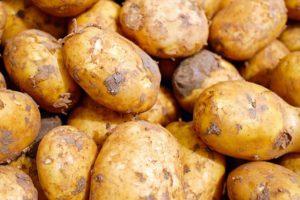
Second earlies take slightly longer than first earlies, and you can be expected to harvest the potatoes within 14-17 weeks after planting, whilst main crops take longer than 18 weeks. The good news is that all three types of potatoes can be grown successfully in containers, with main crop potatoes requiring a larger container to produce their tubers.
TYPES OF POTATOES
First earlies can be grown in a 30-35 litre containers, in which 3 chitted seed potatoes (chitting will be explained later) are planted equidistant from each other. As a rule of thumb, allow 14 litres of compost per seed potato.
Second earlies can be grown in similar sized containers, also using 3 chitted seed potatoes at an equal distance between each other. The only difference is that second earlies tend to be planted later and have a longer growing period. Second earlies and first earlies tend to be similar in size but still harvested small to get the best tasting new potatoes. If you leave second earlies for a long time, they can become big as main crop potatoes.
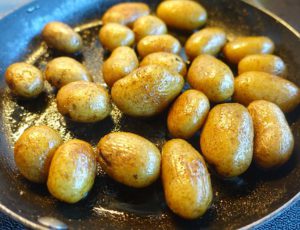
Main crops need extra room and so I would recommend that the seed potatoes are grown in a 50 litre container, where 3 seed potatoes are planted in. If you want to plant extra seed potatoes (for example 5) then I would recommend using a large half-wooden barrel for this purpose. The main difference between main crops and earlies is that the potatoes do not necessarily need chitting, but it would not harm them if you do it or not.
You can grow potatoes in standard 40 litres plastic grow bags. They are good for a while but after a few seasons, due to moisture and sunlight, the bags tend to break down. I have used them in the past but they do rip when you are lifting them up, in a similar way a ‘bag of life’ rips when it is full of heavy shopping. They are cheaper than proper plastic containers, but in this more environmentally times, this may not be feasible, as the plastic will have to be disposed of in landfill.
CHITTING POTATOES
Before planting first and second earlies, it is advised to chit the seed potatoes, so that the crop will produce earlier than it would normally do. Main crop seed potatoes, on the other hand, it is not always necessary to chit. I leave it up to you as a reader, if you want to chit these potatoes or not.
But what is chitting?
Chitting is a method in which the growing process is accelerated by getting the seed potatoes to form small, stubby shoots in the eyes of the potatoes. The small, stubby shoots are called chits, and are encouraged to help the seed potatoes to be further along the growing process, and so produce the potatoes earlier than that would be expected.
The process is quite straightforward. All you need is an egg box (a box where the egg original come from) or a cell tray in which a seed potato is placed in each vacant cell or egg pocket. You have to examine each seed potatoes to find the eyes, where the chits will emerge (the eyes look like small impression in the potatoes) from and place them upwards in the cell tray or egg box.
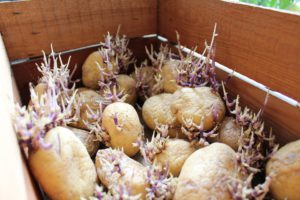
Even I as an experienced gardener sometimes get it wrong, with the eyes facing downwards. Do not worry as once the chits start to emerge from the bottom. You can see this happening and then just turn the seed potato around. We all make mistakes.
Once the seed potatoes have been placed in the egg boxes or cell seed trays, place them in a light, frost-free area., such as a greenhouse, or indoors away from direct sunlight. Do not place in the dark as this will create weak long white sprouts to be formed, and this is not the right type of chit.
The chit should be short, stubby and green on top. The chitting process can take up to 6-8 weeks. After the seeds potatoes have been chitted that it can be planted.
Do not chit shop bought potatoes as they have been sprayed with a chemical that reduces the chit from being formed.
WHEN TO PLANT POTATOES
First earlies are traditionally planted on St Patrick’s Day (17th March) or Good Friday If Easter is early. I would plant first earlies in late March, as long as no hard frost is forecasted. Potatoes cannot tolerate any hard frosts, as this will blacken leaves and shoots.
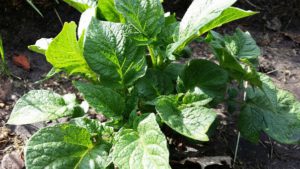
Do not worry as they will soon recover from any damage as long as the new shots are not totally killed by it. To protect from hard frosts you can cover the shoots with old newspaper or horticultural fleece.
Second earlies tend to be planted in Early April, whilst main crops from Mid-April.
HOW TO PLANT POTATOES
Potatoes tend to do well when planted in multipurpose compost mixed with slow release fertilizer designed for potatoes, or something like fish, blood, and bone. It is best to do this at the same time as the seed potatoes are planted. The potato plants will require feeding and it is better to use a liquid tomato fertilizer once every two weeks in order to produce a heavy crop.
As the plants grow it is advised to earth up the haulms (the stems) in order to produce a bigger crop. This is because as the potatoes grow it forms new roots along the stems, thus increasing your yields. All that is required is to let the stem grow about 10cm up, add more compost mixed with slow release fertilizer up to the leaves.
Repeat once or twice more in the growing season until the compost level almost reaches the top of the container. It is up to you how many times you need to earth up.
WHEN TO HARVEST POTATOES
The first earlies tends to be harvested soon after flowering, if it flowers, as not all varieties do, You can wait two weeks after flowering before harvesting your crop. Second earlies can be harvested after 14 weeks, main crops are best harvested two weeks after the stem and leaves have died back.
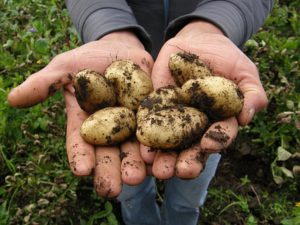
The two weeks is recommended to allow the skin of the tubers to harden, which is best for storage. Potatoes can be harvested as baby new potatoes to the size of a massive baked potato, it is left to you to decide.
There are hundreds of varieties of potatoes that can be grown covering all three categories. It is best to experiment to find which flavour that your family prefers and which potato grows well where you live.
PROBLEMS WITH POTATO PLANTS AND HOW TO STORE THEM
The biggest problem facing potato growers is blight, a fungal disease that starts as a small patch on leaves. It can spread within 24 hours to all areas, even to the tubers underground. Eventually, the plant will die. Main crops tend to be affected more than first and second earlies, as they are harvested earlier in the season, where the disease is less prevalent.
Blight likes hot and humid weather, which occurs in August and September. To combat this disease breeder have developed blight resistant varieties such as Sarpo Mara and other members of the Sarpo family, and Vales of Sovereign.

If you grow potatoes in a potato barrel with an opening door at the bottom, will allow the potatoes of the right size to be harvested. The smaller potatoes are allowed to grow on.
One harvested leave the potatoes in a dry, dark area. This is because light will cause them to turn green. Green potatoes are mildly toxic and can cause an upset stomach if eaten.
TOMATOES
Tomatoes are an ideal crop for those who have little growing space such as balconies, where a single pot or hanging basket can provide a significant harvest.
A lot of growers will testify that homegrown tomatoes will taste better than any shop bought varieties. The problem here is that supermarkets only offer a very limited number of varieties whilst seed suppliers often offers hundreds of varieties. You can literally go crazy growing a number of tomato varieties.
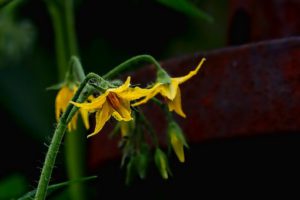
Tomatoes come into two main growing types; determinate or cordon type or indeterminate, bush types. In cordon types, any side shoots that are produced need to be nipped out, so that no energy is wasted in producing side branches and smaller fruits. These tomatoes are ideally grown up canes from a large diameter pot of 30cm.
DETERMINATE OR INDETERMINATE, WHY THIS MATTERS
The bush or determinate types tend to grow shorter but any side shoots are allowed to form and grow naturally and are not pinched out. The plant will eventually reach a height and width and will stop growing. There are large plants, and can only be grown in large pots, with plenty of stalking.
Dwarf bush types also exist and are suitable for growing in small pots or hanging baskets.
Tomato seeds will store for around three years and if you want to grow a
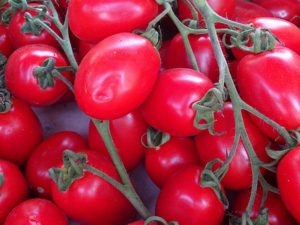
number of varieties, then you can swap seeds with your friends or a seed swapping event. Any extra tomato plants you have can be sold for a small profit.
Some varieties of tomatoes are suitable for greenhouse growing, whilst others can be grown outside in a sunny, sheltered spot. So some research is required to see if the seed you choose is suitable for the location where you plan to plant it.
Tomatoes come in different shapes and sizes and colours. You can have red, yellow, green, white and even dark purple, almost black.
TYPES OF TOMATOES
Most tomato shapes and sizes are:
Cherry– A small round tomato of 15-20mm, which are often grown in pots and hanging baskets They can be either determinate or indeterminate,
Salad/Standard– The next size up producing a 50 to 60mm tomato that is often used in salads. All plants in this category are indeterminate.
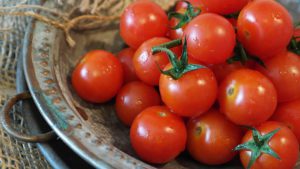
Plum– These oval shape tomatoes produce cooking varieties that are suitable for making tomato sauces. These varieties tend to be semi-determinate in that some of the side branches are allowed to grow, so producing larger crops.
Beef- These large succulent tomatoes are often used in sandwiches. They can grow large up to 150mm in size. All of these tomatoes in this category are indeterminate.
HOW TO GROW TOMATOES
All tomatoes are started in heat, where you can use a propagator or a window sill. It is best to start seeds in a seed tray, before pricking out and transferring to an 8cm pot. The seedling needs to be planted deep up to the cotyledon leaves. Start greenhouse tomatoes in early March, whilst outside varieties in mid to late March.
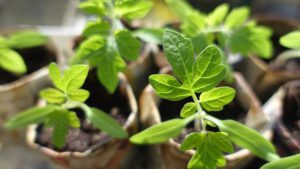
By the end of April/early May, you can plant the greenhouse tomatoes in their final position. Early May for the greenhouse and mid-May for outside varieties. Tomatoes cannot stand even a small frost, so protection may be required.
The quantity and quality of the fruit depending on how well the plant develops, and its ability to concentrate nutrients into the fruits. As this is dependent on its roots, then a better root system will result in a stronger plant.
TOMATO PLANTS PRODUCES TWO KINDS OF ROOTS
If you look closely at the base of a tomato plant, you will see fine ‘hairs’ which tends to root if they are placed in the soil or compost. Planted deeply these hairs will turn them into new roots. This will result in a better root system, better growth, and more fruits.
Tomato plants produce two kinds of roots; a surface root near the top of the compost, where the plant gets all its nutrients, and a bottom roots where the plants get its moisture requirements. This can be exploited by the tomato grower by placing a tomato pot over the tomato plant in the container and filling it with multipurpose compost.
This is only recommended for indeterminate tomatoes and not determinate tomatoes.
HOW TO LOOK AFTER YOUR TOMATO PLANTS
During the growing season, you can add liquid tomato fertilizer to the tomato grow pot to feed the plant and add water to the container below. The plant will be happy in this way.
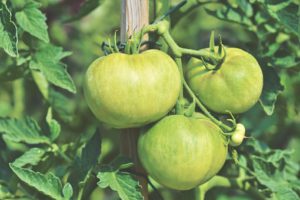
Most tomato plants need staking by using bamboo canes, tying the stems to the cane as the plants grow up. Tomatoes need watering regularly. In a hot, dry sunny weather, twice as much water would be required than that on a cloudy day. This is why thorough watering is required.
Determinate type tomato plants will need all side shoots to be removed, whilst bush types can be left alone.
To help the plant to set fruit in dry weather, misting will promote fruit setting. Once the first fruits have set, then it is recommended that a tomato fertilizer is used at the manufacturer’s recommended dosage. Do not overfeed the plant, as this will not benefit the plant or you.
WHAT TO DO LATER IN THE SEASON
When the plants have reached the top of the greenhouse or 7 trusses have been produced, then it is time to pinch out the growing tip. For outside plants, pinch out the tips when 4 trusses have formed. This will force the plant to put all of its energy into the crop that is already there before the season ends. The plants will react by producing more side shoots, so be vigilant and remove them as they form.
Towards the end of the seasons, any leaves need to be removed to help the fruit to ripen. Smokers should not handle or smoke near tomato plants, as they can spread the tobacco mosaic virus to the plants.
PROBLEMS WITH TOMATO PLANTS
Tomato outside can suffer from blight and this can kill plants in a humid, hot summer in September. To counteract this, breeders have developed blight resistant varieties such as ‘Crimson Crush’ and ‘Mountain Magic’.
Sometimes tomatoes suffer from a magnesium deficiency, which prevents the plants from up taking nitrogen. The plant starts suffering from yellowing of the leaves between the veins. It starts lower down the plant but quickly spreads upwards if the problem is not corrected.

Treatment is easy, all you need to do is mix 30g of Epsom salt per litre of water, and spray it on the plant every couple of days. You can also add 10g per litre of water to the roots, every week as you water.
The chances are you will have green tomatoes at the end of the season. You can either ripen them with a banana in a paper bag or in a closed draw. Banana release ethene gas which promotes ripening of fruits. You can also use them to make green jam or a green tomato chutney.
CONCLUSIONS
In this article, the growing of potatoes and tomatoes in containers have been discussed. Growing potatoes is so dependent on the variety used, which not only determines the pot size but when the tubers will be harvested.
Tomatoes come in two varieties, with both suitable to be grown in containers. Both potatoes and tomatoes can suffer from blight, but by using blight resistant varieties can prevent the disease from damaging your crops.
The varieties of what to use are dependent on your local growing conditions. No matter what there are varieties of tomatoes and potatoes that is for you.
If you have any questions or comments, please leave them below, and I will get back to you
Happy Growing.

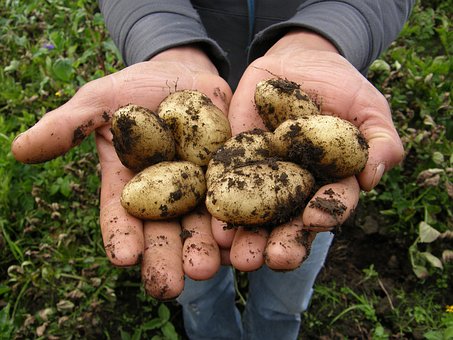
Having grown tomatoes before I did get yellow leaves which you say in this article is magnesium deficiency. As I didn’t know the remedy I gave up on them. Which is a shame.
This time around I will make sure I have epsom salts in the house, great tip so thank you very much.
I wont say I have green fingers but I do try.
Hi Dianne
Thank you for your kind words. With plants in my experience, it is better to find a solution that works before throwing them away, as sometimes it is simple as more watering, less watering or feeding with the right type of feed. I hope you use my article to help you become a better gardener.
Kind Regards
Antonio
Hey,
thank you for the follow-up! Your post covers all the details necessary to start growing potatoes and tomatoes. It is great that you can start growing some vegetables on your balcony!
I have a question concerning the diseases: how can you prevent blight from attacking potatoes that are not resistant to it? Is there any method or do you have to hope that this won’t happen?
Hi Alex
Thank you for those kind words. You use to be able to buy a copper fungicide such as Bordeaux mixture, but this has been banned in Europe for a number of years. There is no way of avoiding it but hope and pray that the summer is not hot and humid. If you live in a blight are the only solution is to grow a blight-resistant variety or give up growing potatoes and tomatoes.
Hope that Helps
Antonio
I really like your presentation. I have some questions, can I use containers to plant potatoes as a nursery? I mean, I use containers to plant potatoes. And after sometimes remove them from containers to plant in the field, can it be successful?
I would like to do that and see if I can avoid some diseases at an early stage. And because I think it can be more easy to fertilize. I mainly use bio fertilizer and having that concentrated in a small container may give better result, I think. I have never tried it, have you?
I do not plant potatoes in containers but with your information, I will try. Especially the second earlies. But what kind of material should I choose for the containers? Can I use clay? Because as you said plastic container is not good for the evironment.
Thanks for sharing
Hi Adyns68
Thank you for your kind words as they are very much appreciated. Yes, of course, you can grow potatoes in a container in a nursery, and this is a good way of getting children to grow their own food.
You can transplant container potatoes into the ground, as long as it is done at an early stage so that the roots are not bound to the pot. This can be quite successful as you can get an early start.
Any feed you use for vegetable is okay, as potatoes need high nitrogen and high potassium to form tubers. I have used organic and inorganic feeds with great success. I leave it to the gardener to decide which to use.
You can use plastic pots as they retain more moisture than terracotta pots, but do not use cheap plastic that breaks down after a couple of seasons. I grow mine in heavy duty plastic pots that have been used for many years. Look out for heavy duty and you will be safe, as these containers do not breakdown.
Thanks
Antonio
This information comes at a crucial point in my experience as a vegetable gardener as I’ve had so many setbacks this year with geese, dogs and birds believing that the plants were planted for their consumption and thus the vegetables never had a chance to grow to maturity!
I tried my hand at planting the seeds in seedling containers, but they just up and died too!
I feel so frustrated as I so want to put food on the table and not have to go out and buy it as finances are strained.
Reading your post, I have gleaned a lot of information and tips that I did not know before and in fact we have just planted Sweet Potatoes in the ground that had chitted (unknown to us before we read your article) and so I will now keep a watchful eye on them to make sure they don’t get blight. However, we live in the opposite hemisphere to you, so we will be entering winter in June, so I think we may be alright.
Moving on to the tomatoes – WOW! I didn’t know that there were so many different coloured tomatoes! That is an eye-opener and great for the trendy chef who wants to put colour into a salad or main dish.
I have learnt SO much from your post about how to successfully plant tomatoes now and I am a lot happier knowing that I have a reference to go back to, to make sure that I can raise good vegetables to put on the table.
Many thanks for an amazing and inspiring post!
Hi Learn
I am so glad that you enjoyed the article and have obtained plenty of knowledge from it. It is all about the information and how to use that information to your advantage. Container growing is for those who do not have a garden or cannot grow in the ground as the soil is not suitable.
Sweet potatoes are in fact another crop than potatoes and tend to planted as with slips. Sweet potatoes are an acquired taste and are not really suitable to be grown in containers Potatoes, on the other hand, is grown worldwide and are really suitable for containers.
Tomatoes are a stable to many growers especially if you like pasta and pizza dishes.
Kind Regards
Antonio
A very informative article on spuds and tomatoes. I tend to use above ground gardening, which in a way is containerised! But I modified this method for both my dad and my good friend, who was a paraplegic.
When dad retired he got more involved in growing his own food. I gave him a copy of my reference, a great book by Ester Dean re no dig gardening. His solution to growing the potatoes was very similar to yours but modified. He used one of the old, heavy duty plastic garbage bins. He cut slits randomly in the sides.
Then he did Ester’s layering of straw, lucerne (alfalfa) and good compost with a sprinkling of Organic Life (” https://rockypoint.com.au/products/organic-life/“). The first layering just covered the spud. As soon as a green tip appeared another layering happened. And so on.
When the growth reached the top of the bin, he left it alone. Then when he wanted a spud, he reached in a slit and found one the right size! A good brush and no washing was needed.
Also in regard to chitting. Great explanation however I would like to add that seed potatoes here in Australia, are grown and then turned over to lay on the surface in full sunlight. This actually greens off the spuds and that acts as a disease deterrent when they are planted. So I set aside some egg sized potatoes in my aerated storage bin. Two weeks before planting I lay them out in full sun. I have had no diseases including blight so something must work.
The last season of spuds I ended up with one 3.7kg one! Boy was it a beauty and edible all the way through.
As for my wheelchair bound friend, I made containers from wire and burlap. Cut slits and planted cherry tomatoes and strawberries. Then hung them at the right height for wheelchair harvesting. A good point with this method was she could easily water by pointing the hose at the burlap. No trying to reach the top or fiddly bottom watering system.
Thanks for this article.
Ciao
Helen
Hi Helen
It is always great to learn how other people garden. The spud was a whopper and often wish I could grow one that big. I really enjoyed reading your long and detailed explanation of how you garden and how gardening has been altered for your disabled friend. You may find this article useful Why Container Gardening is Better For Those With Disabilities
Kind Regards
Antonio